A Comparative Report on the Education Systems of England and Ireland
VerifiedAdded on 2023/01/17
|10
|2581
|1
Report
AI Summary
This report provides a comparative analysis of the education systems of England and Ireland. It begins with an introduction to each country's educational framework, detailing the structure of primary, secondary, and higher education. The report delves into the similarities and differences between the two systems, examining factors such as government influence, curriculum design, and the age at which formal education commences. The main body of the report discusses the historical influences and key policies shaping education in both countries. The report also highlights the unique aspects of each system, such as the role of religious communities in Ireland's primary schools and the different stages of education in England & Wales. The report concludes by summarizing the key findings and offering insights into the strengths and challenges of each educational approach. This report aims to provide a clear understanding of how education systems function in both England and Ireland, contributing to a broader understanding of comparative education.
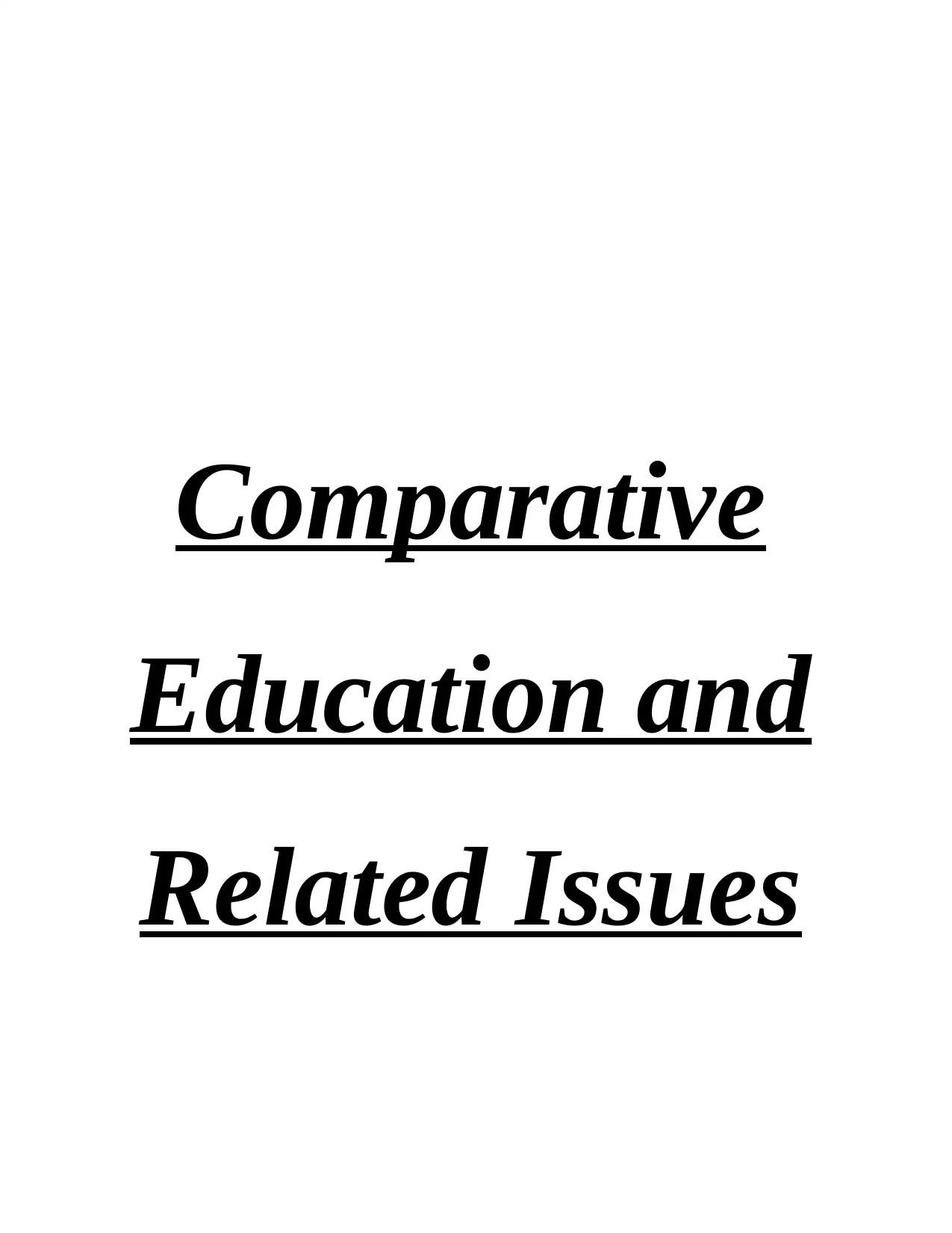
Comparative
Education and
Related Issues
Education and
Related Issues
Paraphrase This Document
Need a fresh take? Get an instant paraphrase of this document with our AI Paraphraser
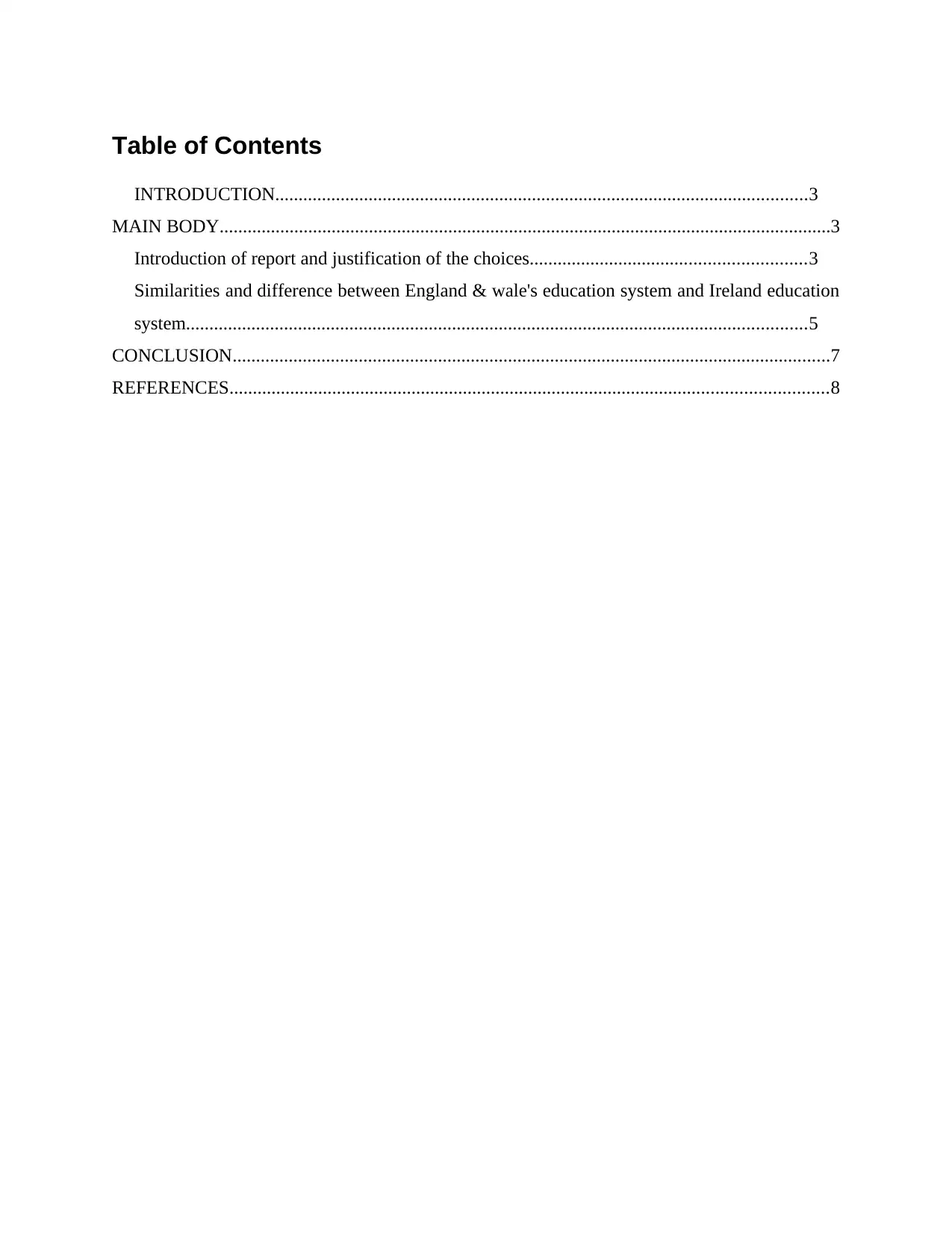
Table of Contents
INTRODUCTION..................................................................................................................3
MAIN BODY...................................................................................................................................3
Introduction of report and justification of the choices...........................................................3
Similarities and difference between England & wale's education system and Ireland education
system.....................................................................................................................................5
CONCLUSION................................................................................................................................7
REFERENCES................................................................................................................................8
INTRODUCTION..................................................................................................................3
MAIN BODY...................................................................................................................................3
Introduction of report and justification of the choices...........................................................3
Similarities and difference between England & wale's education system and Ireland education
system.....................................................................................................................................5
CONCLUSION................................................................................................................................7
REFERENCES................................................................................................................................8
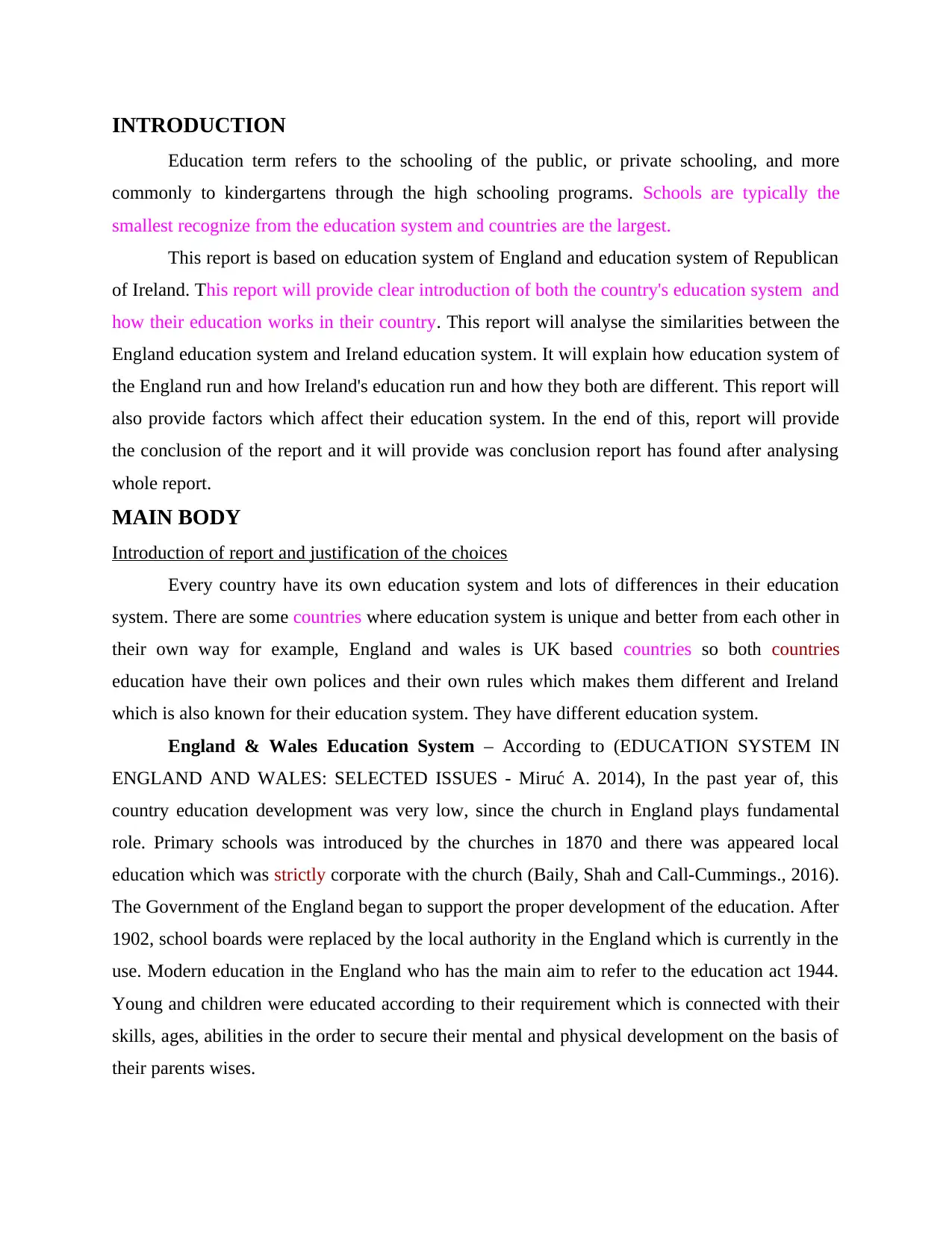
INTRODUCTION
Education term refers to the schooling of the public, or private schooling, and more
commonly to kindergartens through the high schooling programs. Schools are typically the
smallest recognize from the education system and countries are the largest.
This report is based on education system of England and education system of Republican
of Ireland. This report will provide clear introduction of both the country's education system and
how their education works in their country. This report will analyse the similarities between the
England education system and Ireland education system. It will explain how education system of
the England run and how Ireland's education run and how they both are different. This report will
also provide factors which affect their education system. In the end of this, report will provide
the conclusion of the report and it will provide was conclusion report has found after analysing
whole report.
MAIN BODY
Introduction of report and justification of the choices
Every country have its own education system and lots of differences in their education
system. There are some countries where education system is unique and better from each other in
their own way for example, England and wales is UK based countries so both countries
education have their own polices and their own rules which makes them different and Ireland
which is also known for their education system. They have different education system.
England & Wales Education System – According to (EDUCATION SYSTEM IN
ENGLAND AND WALES: SELECTED ISSUES - Miruć A. 2014), In the past year of, this
country education development was very low, since the church in England plays fundamental
role. Primary schools was introduced by the churches in 1870 and there was appeared local
education which was strictly corporate with the church (Baily, Shah and Call-Cummings., 2016).
The Government of the England began to support the proper development of the education. After
1902, school boards were replaced by the local authority in the England which is currently in the
use. Modern education in the England who has the main aim to refer to the education act 1944.
Young and children were educated according to their requirement which is connected with their
skills, ages, abilities in the order to secure their mental and physical development on the basis of
their parents wises.
Education term refers to the schooling of the public, or private schooling, and more
commonly to kindergartens through the high schooling programs. Schools are typically the
smallest recognize from the education system and countries are the largest.
This report is based on education system of England and education system of Republican
of Ireland. This report will provide clear introduction of both the country's education system and
how their education works in their country. This report will analyse the similarities between the
England education system and Ireland education system. It will explain how education system of
the England run and how Ireland's education run and how they both are different. This report will
also provide factors which affect their education system. In the end of this, report will provide
the conclusion of the report and it will provide was conclusion report has found after analysing
whole report.
MAIN BODY
Introduction of report and justification of the choices
Every country have its own education system and lots of differences in their education
system. There are some countries where education system is unique and better from each other in
their own way for example, England and wales is UK based countries so both countries
education have their own polices and their own rules which makes them different and Ireland
which is also known for their education system. They have different education system.
England & Wales Education System – According to (EDUCATION SYSTEM IN
ENGLAND AND WALES: SELECTED ISSUES - Miruć A. 2014), In the past year of, this
country education development was very low, since the church in England plays fundamental
role. Primary schools was introduced by the churches in 1870 and there was appeared local
education which was strictly corporate with the church (Baily, Shah and Call-Cummings., 2016).
The Government of the England began to support the proper development of the education. After
1902, school boards were replaced by the local authority in the England which is currently in the
use. Modern education in the England who has the main aim to refer to the education act 1944.
Young and children were educated according to their requirement which is connected with their
skills, ages, abilities in the order to secure their mental and physical development on the basis of
their parents wises.
⊘ This is a preview!⊘
Do you want full access?
Subscribe today to unlock all pages.

Trusted by 1+ million students worldwide
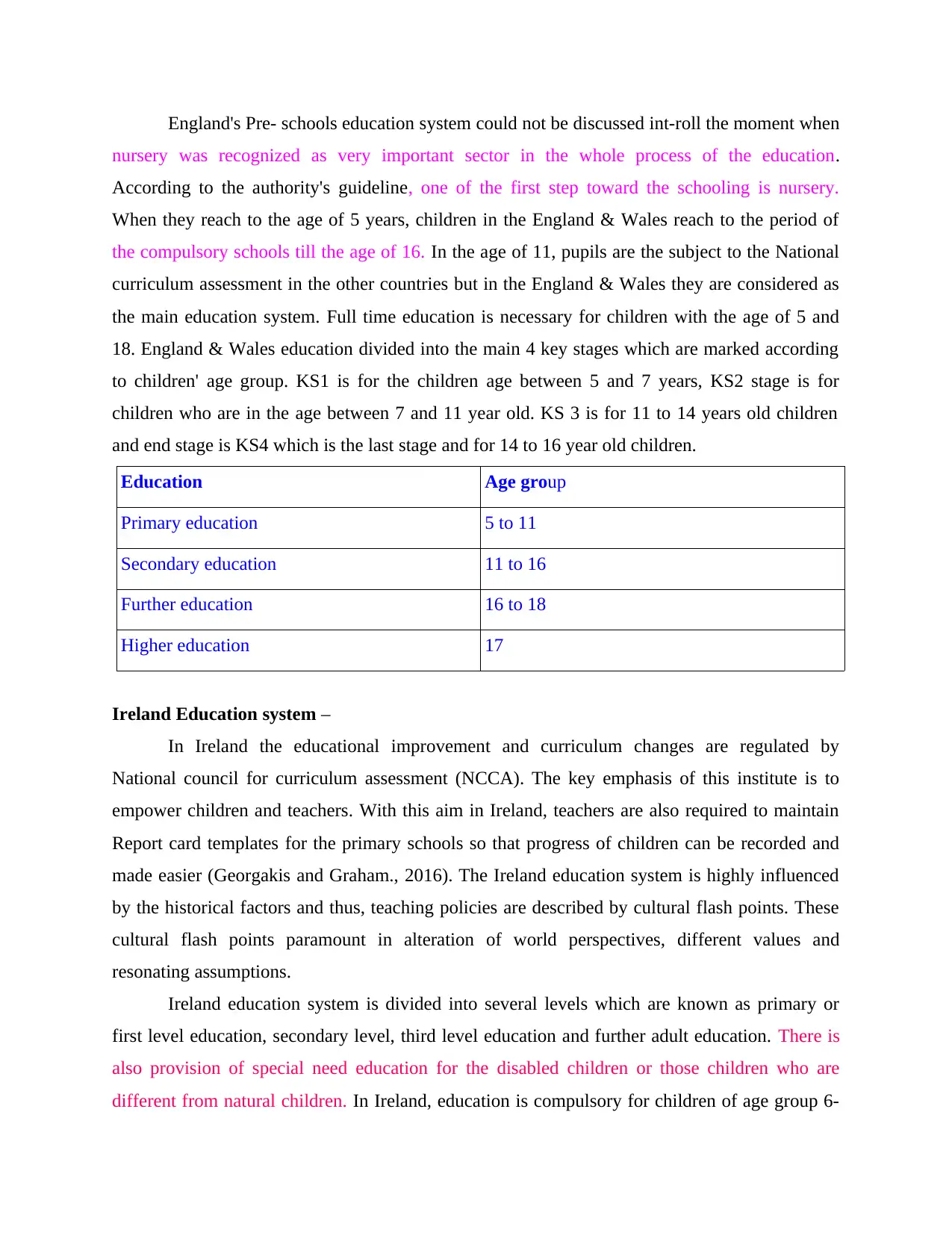
England's Pre- schools education system could not be discussed int-roll the moment when
nursery was recognized as very important sector in the whole process of the education.
According to the authority's guideline, one of the first step toward the schooling is nursery.
When they reach to the age of 5 years, children in the England & Wales reach to the period of
the compulsory schools till the age of 16. In the age of 11, pupils are the subject to the National
curriculum assessment in the other countries but in the England & Wales they are considered as
the main education system. Full time education is necessary for children with the age of 5 and
18. England & Wales education divided into the main 4 key stages which are marked according
to children' age group. KS1 is for the children age between 5 and 7 years, KS2 stage is for
children who are in the age between 7 and 11 year old. KS 3 is for 11 to 14 years old children
and end stage is KS4 which is the last stage and for 14 to 16 year old children.
Education Age group
Primary education 5 to 11
Secondary education 11 to 16
Further education 16 to 18
Higher education 17
Ireland Education system –
In Ireland the educational improvement and curriculum changes are regulated by
National council for curriculum assessment (NCCA). The key emphasis of this institute is to
empower children and teachers. With this aim in Ireland, teachers are also required to maintain
Report card templates for the primary schools so that progress of children can be recorded and
made easier (Georgakis and Graham., 2016). The Ireland education system is highly influenced
by the historical factors and thus, teaching policies are described by cultural flash points. These
cultural flash points paramount in alteration of world perspectives, different values and
resonating assumptions.
Ireland education system is divided into several levels which are known as primary or
first level education, secondary level, third level education and further adult education. There is
also provision of special need education for the disabled children or those children who are
different from natural children. In Ireland, education is compulsory for children of age group 6-
nursery was recognized as very important sector in the whole process of the education.
According to the authority's guideline, one of the first step toward the schooling is nursery.
When they reach to the age of 5 years, children in the England & Wales reach to the period of
the compulsory schools till the age of 16. In the age of 11, pupils are the subject to the National
curriculum assessment in the other countries but in the England & Wales they are considered as
the main education system. Full time education is necessary for children with the age of 5 and
18. England & Wales education divided into the main 4 key stages which are marked according
to children' age group. KS1 is for the children age between 5 and 7 years, KS2 stage is for
children who are in the age between 7 and 11 year old. KS 3 is for 11 to 14 years old children
and end stage is KS4 which is the last stage and for 14 to 16 year old children.
Education Age group
Primary education 5 to 11
Secondary education 11 to 16
Further education 16 to 18
Higher education 17
Ireland Education system –
In Ireland the educational improvement and curriculum changes are regulated by
National council for curriculum assessment (NCCA). The key emphasis of this institute is to
empower children and teachers. With this aim in Ireland, teachers are also required to maintain
Report card templates for the primary schools so that progress of children can be recorded and
made easier (Georgakis and Graham., 2016). The Ireland education system is highly influenced
by the historical factors and thus, teaching policies are described by cultural flash points. These
cultural flash points paramount in alteration of world perspectives, different values and
resonating assumptions.
Ireland education system is divided into several levels which are known as primary or
first level education, secondary level, third level education and further adult education. There is
also provision of special need education for the disabled children or those children who are
different from natural children. In Ireland, education is compulsory for children of age group 6-
Paraphrase This Document
Need a fresh take? Get an instant paraphrase of this document with our AI Paraphraser
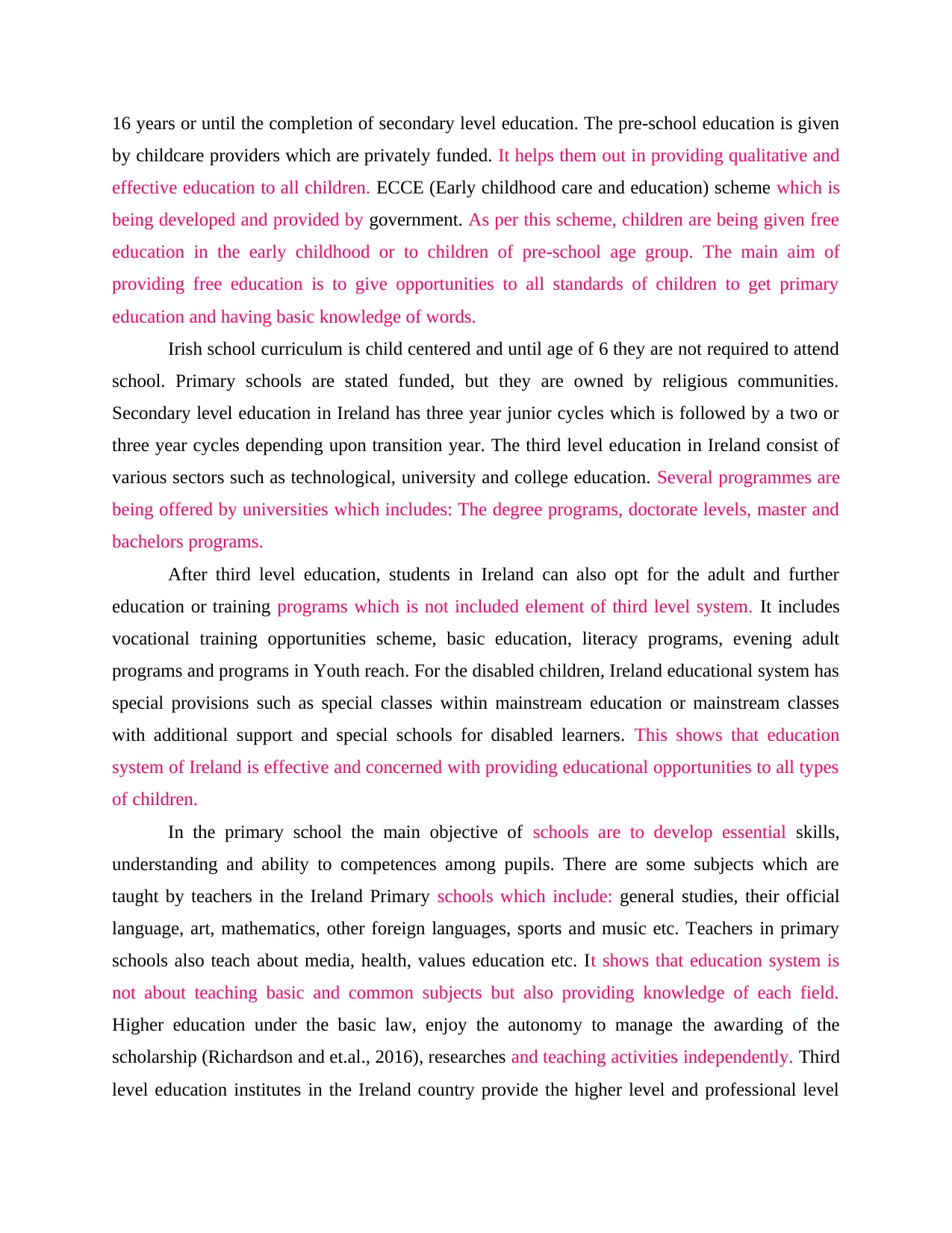
16 years or until the completion of secondary level education. The pre-school education is given
by childcare providers which are privately funded. It helps them out in providing qualitative and
effective education to all children. ECCE (Early childhood care and education) scheme which is
being developed and provided by government. As per this scheme, children are being given free
education in the early childhood or to children of pre-school age group. The main aim of
providing free education is to give opportunities to all standards of children to get primary
education and having basic knowledge of words.
Irish school curriculum is child centered and until age of 6 they are not required to attend
school. Primary schools are stated funded, but they are owned by religious communities.
Secondary level education in Ireland has three year junior cycles which is followed by a two or
three year cycles depending upon transition year. The third level education in Ireland consist of
various sectors such as technological, university and college education. Several programmes are
being offered by universities which includes: The degree programs, doctorate levels, master and
bachelors programs.
After third level education, students in Ireland can also opt for the adult and further
education or training programs which is not included element of third level system. It includes
vocational training opportunities scheme, basic education, literacy programs, evening adult
programs and programs in Youth reach. For the disabled children, Ireland educational system has
special provisions such as special classes within mainstream education or mainstream classes
with additional support and special schools for disabled learners. This shows that education
system of Ireland is effective and concerned with providing educational opportunities to all types
of children.
In the primary school the main objective of schools are to develop essential skills,
understanding and ability to competences among pupils. There are some subjects which are
taught by teachers in the Ireland Primary schools which include: general studies, their official
language, art, mathematics, other foreign languages, sports and music etc. Teachers in primary
schools also teach about media, health, values education etc. It shows that education system is
not about teaching basic and common subjects but also providing knowledge of each field.
Higher education under the basic law, enjoy the autonomy to manage the awarding of the
scholarship (Richardson and et.al., 2016), researches and teaching activities independently. Third
level education institutes in the Ireland country provide the higher level and professional level
by childcare providers which are privately funded. It helps them out in providing qualitative and
effective education to all children. ECCE (Early childhood care and education) scheme which is
being developed and provided by government. As per this scheme, children are being given free
education in the early childhood or to children of pre-school age group. The main aim of
providing free education is to give opportunities to all standards of children to get primary
education and having basic knowledge of words.
Irish school curriculum is child centered and until age of 6 they are not required to attend
school. Primary schools are stated funded, but they are owned by religious communities.
Secondary level education in Ireland has three year junior cycles which is followed by a two or
three year cycles depending upon transition year. The third level education in Ireland consist of
various sectors such as technological, university and college education. Several programmes are
being offered by universities which includes: The degree programs, doctorate levels, master and
bachelors programs.
After third level education, students in Ireland can also opt for the adult and further
education or training programs which is not included element of third level system. It includes
vocational training opportunities scheme, basic education, literacy programs, evening adult
programs and programs in Youth reach. For the disabled children, Ireland educational system has
special provisions such as special classes within mainstream education or mainstream classes
with additional support and special schools for disabled learners. This shows that education
system of Ireland is effective and concerned with providing educational opportunities to all types
of children.
In the primary school the main objective of schools are to develop essential skills,
understanding and ability to competences among pupils. There are some subjects which are
taught by teachers in the Ireland Primary schools which include: general studies, their official
language, art, mathematics, other foreign languages, sports and music etc. Teachers in primary
schools also teach about media, health, values education etc. It shows that education system is
not about teaching basic and common subjects but also providing knowledge of each field.
Higher education under the basic law, enjoy the autonomy to manage the awarding of the
scholarship (Richardson and et.al., 2016), researches and teaching activities independently. Third
level education institutes in the Ireland country provide the higher level and professional level
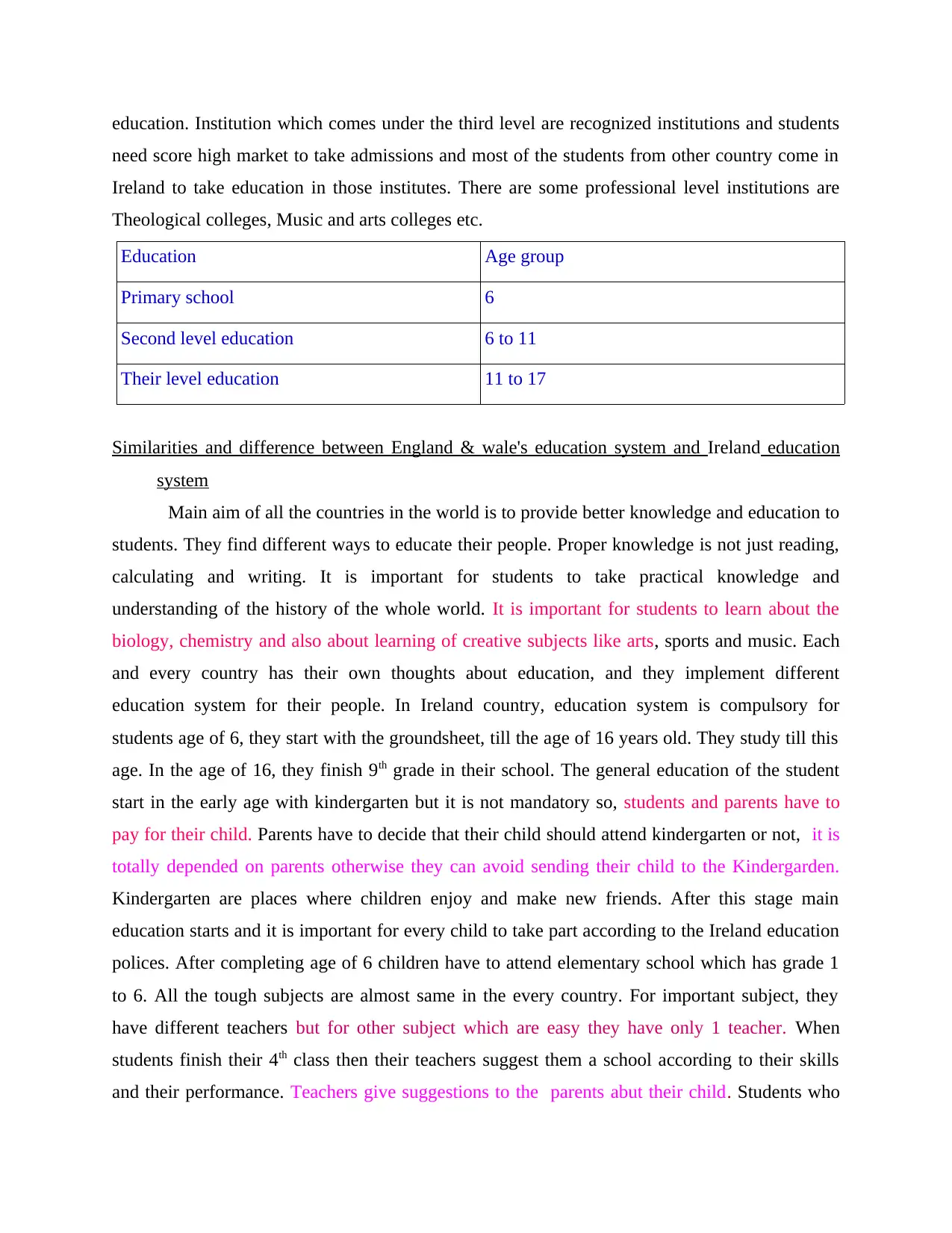
education. Institution which comes under the third level are recognized institutions and students
need score high market to take admissions and most of the students from other country come in
Ireland to take education in those institutes. There are some professional level institutions are
Theological colleges, Music and arts colleges etc.
Education Age group
Primary school 6
Second level education 6 to 11
Their level education 11 to 17
Similarities and difference between England & wale's education system and Ireland education
system
Main aim of all the countries in the world is to provide better knowledge and education to
students. They find different ways to educate their people. Proper knowledge is not just reading,
calculating and writing. It is important for students to take practical knowledge and
understanding of the history of the whole world. It is important for students to learn about the
biology, chemistry and also about learning of creative subjects like arts, sports and music. Each
and every country has their own thoughts about education, and they implement different
education system for their people. In Ireland country, education system is compulsory for
students age of 6, they start with the groundsheet, till the age of 16 years old. They study till this
age. In the age of 16, they finish 9th grade in their school. The general education of the student
start in the early age with kindergarten but it is not mandatory so, students and parents have to
pay for their child. Parents have to decide that their child should attend kindergarten or not, it is
totally depended on parents otherwise they can avoid sending their child to the Kindergarden.
Kindergarten are places where children enjoy and make new friends. After this stage main
education starts and it is important for every child to take part according to the Ireland education
polices. After completing age of 6 children have to attend elementary school which has grade 1
to 6. All the tough subjects are almost same in the every country. For important subject, they
have different teachers but for other subject which are easy they have only 1 teacher. When
students finish their 4th class then their teachers suggest them a school according to their skills
and their performance. Teachers give suggestions to the parents abut their child. Students who
need score high market to take admissions and most of the students from other country come in
Ireland to take education in those institutes. There are some professional level institutions are
Theological colleges, Music and arts colleges etc.
Education Age group
Primary school 6
Second level education 6 to 11
Their level education 11 to 17
Similarities and difference between England & wale's education system and Ireland education
system
Main aim of all the countries in the world is to provide better knowledge and education to
students. They find different ways to educate their people. Proper knowledge is not just reading,
calculating and writing. It is important for students to take practical knowledge and
understanding of the history of the whole world. It is important for students to learn about the
biology, chemistry and also about learning of creative subjects like arts, sports and music. Each
and every country has their own thoughts about education, and they implement different
education system for their people. In Ireland country, education system is compulsory for
students age of 6, they start with the groundsheet, till the age of 16 years old. They study till this
age. In the age of 16, they finish 9th grade in their school. The general education of the student
start in the early age with kindergarten but it is not mandatory so, students and parents have to
pay for their child. Parents have to decide that their child should attend kindergarten or not, it is
totally depended on parents otherwise they can avoid sending their child to the Kindergarden.
Kindergarten are places where children enjoy and make new friends. After this stage main
education starts and it is important for every child to take part according to the Ireland education
polices. After completing age of 6 children have to attend elementary school which has grade 1
to 6. All the tough subjects are almost same in the every country. For important subject, they
have different teachers but for other subject which are easy they have only 1 teacher. When
students finish their 4th class then their teachers suggest them a school according to their skills
and their performance. Teachers give suggestions to the parents abut their child. Students who
⊘ This is a preview!⊘
Do you want full access?
Subscribe today to unlock all pages.

Trusted by 1+ million students worldwide
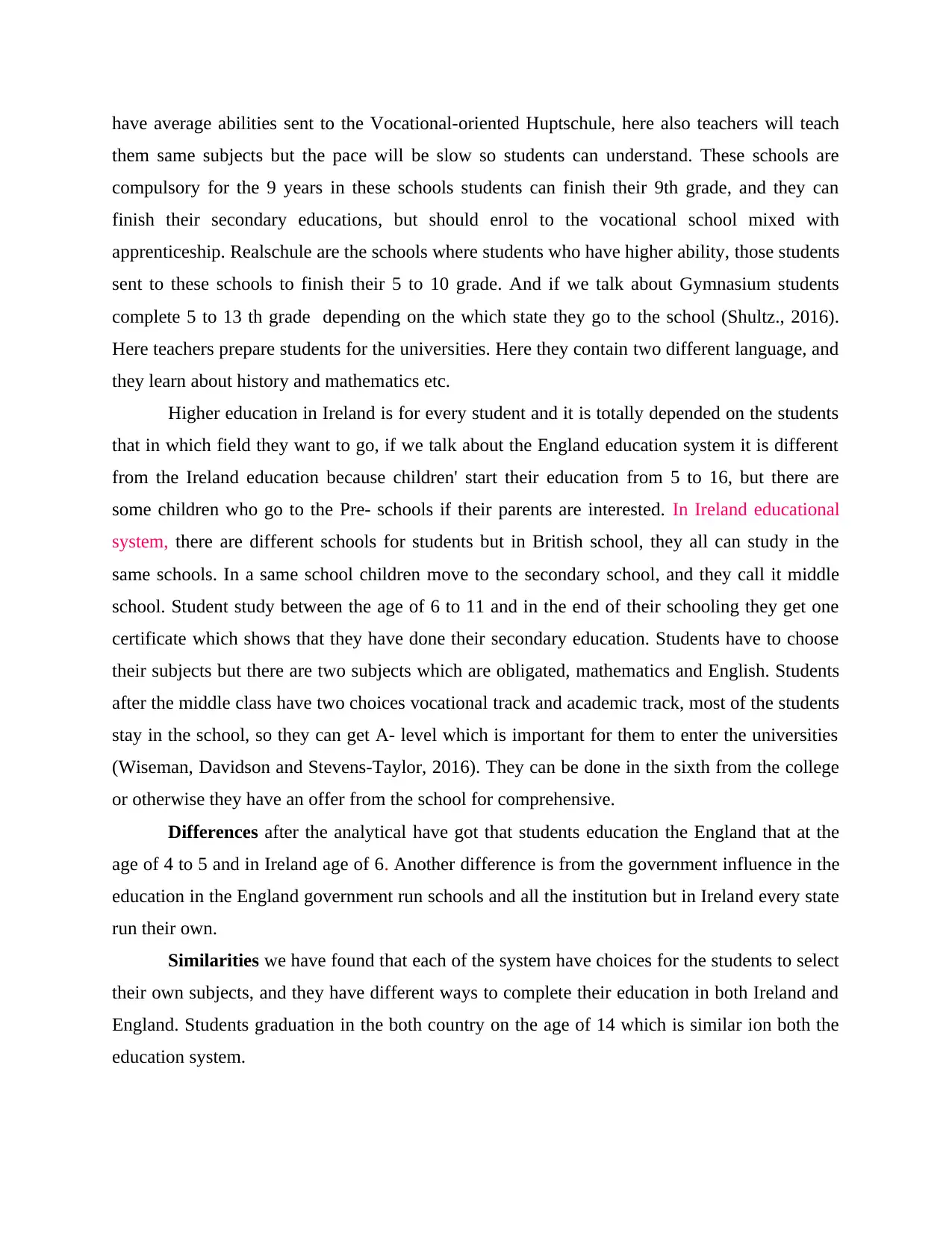
have average abilities sent to the Vocational-oriented Huptschule, here also teachers will teach
them same subjects but the pace will be slow so students can understand. These schools are
compulsory for the 9 years in these schools students can finish their 9th grade, and they can
finish their secondary educations, but should enrol to the vocational school mixed with
apprenticeship. Realschule are the schools where students who have higher ability, those students
sent to these schools to finish their 5 to 10 grade. And if we talk about Gymnasium students
complete 5 to 13 th grade depending on the which state they go to the school (Shultz., 2016).
Here teachers prepare students for the universities. Here they contain two different language, and
they learn about history and mathematics etc.
Higher education in Ireland is for every student and it is totally depended on the students
that in which field they want to go, if we talk about the England education system it is different
from the Ireland education because children' start their education from 5 to 16, but there are
some children who go to the Pre- schools if their parents are interested. In Ireland educational
system, there are different schools for students but in British school, they all can study in the
same schools. In a same school children move to the secondary school, and they call it middle
school. Student study between the age of 6 to 11 and in the end of their schooling they get one
certificate which shows that they have done their secondary education. Students have to choose
their subjects but there are two subjects which are obligated, mathematics and English. Students
after the middle class have two choices vocational track and academic track, most of the students
stay in the school, so they can get A- level which is important for them to enter the universities
(Wiseman, Davidson and Stevens-Taylor, 2016). They can be done in the sixth from the college
or otherwise they have an offer from the school for comprehensive.
Differences after the analytical have got that students education the England that at the
age of 4 to 5 and in Ireland age of 6. Another difference is from the government influence in the
education in the England government run schools and all the institution but in Ireland every state
run their own.
Similarities we have found that each of the system have choices for the students to select
their own subjects, and they have different ways to complete their education in both Ireland and
England. Students graduation in the both country on the age of 14 which is similar ion both the
education system.
them same subjects but the pace will be slow so students can understand. These schools are
compulsory for the 9 years in these schools students can finish their 9th grade, and they can
finish their secondary educations, but should enrol to the vocational school mixed with
apprenticeship. Realschule are the schools where students who have higher ability, those students
sent to these schools to finish their 5 to 10 grade. And if we talk about Gymnasium students
complete 5 to 13 th grade depending on the which state they go to the school (Shultz., 2016).
Here teachers prepare students for the universities. Here they contain two different language, and
they learn about history and mathematics etc.
Higher education in Ireland is for every student and it is totally depended on the students
that in which field they want to go, if we talk about the England education system it is different
from the Ireland education because children' start their education from 5 to 16, but there are
some children who go to the Pre- schools if their parents are interested. In Ireland educational
system, there are different schools for students but in British school, they all can study in the
same schools. In a same school children move to the secondary school, and they call it middle
school. Student study between the age of 6 to 11 and in the end of their schooling they get one
certificate which shows that they have done their secondary education. Students have to choose
their subjects but there are two subjects which are obligated, mathematics and English. Students
after the middle class have two choices vocational track and academic track, most of the students
stay in the school, so they can get A- level which is important for them to enter the universities
(Wiseman, Davidson and Stevens-Taylor, 2016). They can be done in the sixth from the college
or otherwise they have an offer from the school for comprehensive.
Differences after the analytical have got that students education the England that at the
age of 4 to 5 and in Ireland age of 6. Another difference is from the government influence in the
education in the England government run schools and all the institution but in Ireland every state
run their own.
Similarities we have found that each of the system have choices for the students to select
their own subjects, and they have different ways to complete their education in both Ireland and
England. Students graduation in the both country on the age of 14 which is similar ion both the
education system.
Paraphrase This Document
Need a fresh take? Get an instant paraphrase of this document with our AI Paraphraser
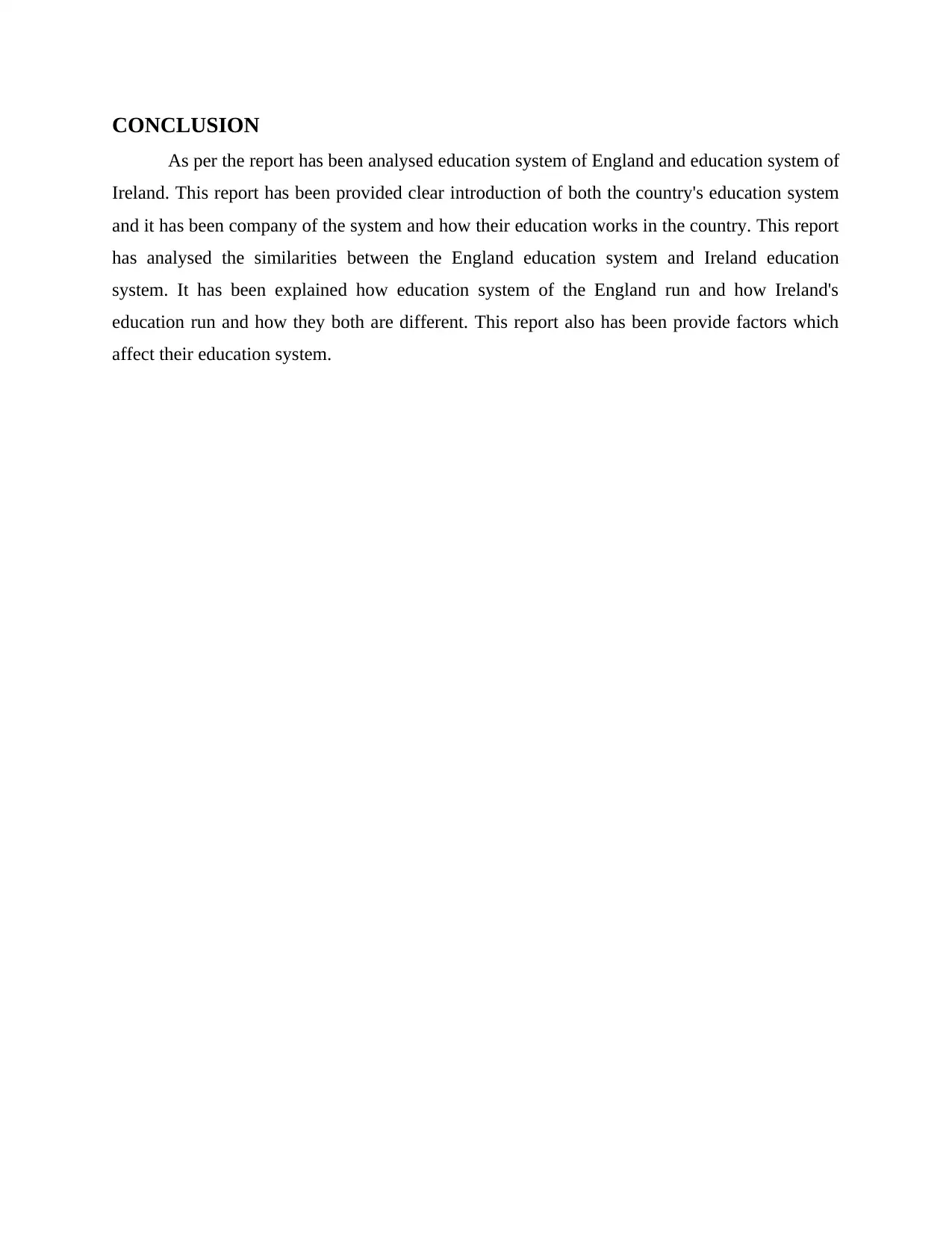
CONCLUSION
As per the report has been analysed education system of England and education system of
Ireland. This report has been provided clear introduction of both the country's education system
and it has been company of the system and how their education works in the country. This report
has analysed the similarities between the England education system and Ireland education
system. It has been explained how education system of the England run and how Ireland's
education run and how they both are different. This report also has been provide factors which
affect their education system.
As per the report has been analysed education system of England and education system of
Ireland. This report has been provided clear introduction of both the country's education system
and it has been company of the system and how their education works in the country. This report
has analysed the similarities between the England education system and Ireland education
system. It has been explained how education system of the England run and how Ireland's
education run and how they both are different. This report also has been provide factors which
affect their education system.
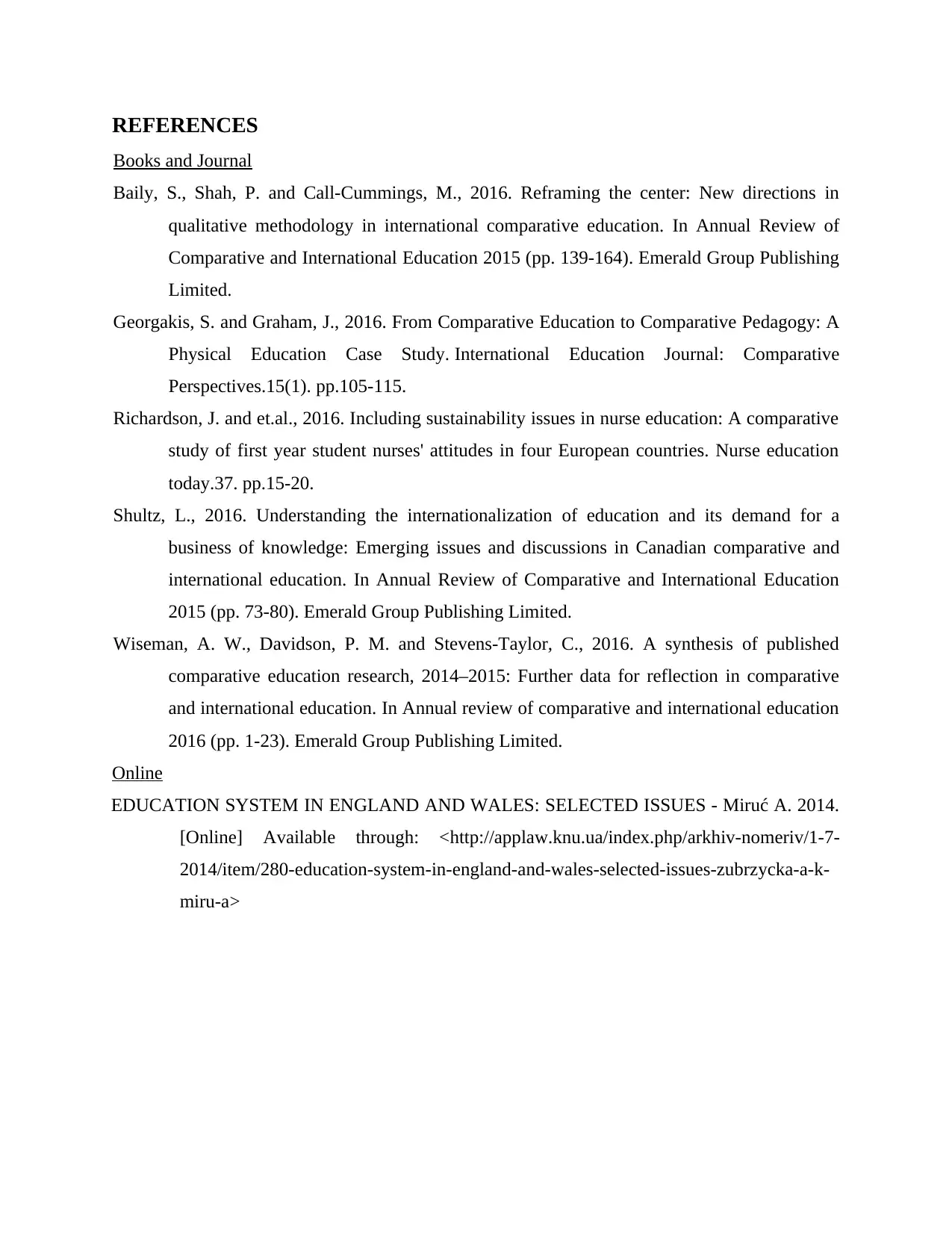
REFERENCES
Books and Journal
Baily, S., Shah, P. and Call-Cummings, M., 2016. Reframing the center: New directions in
qualitative methodology in international comparative education. In Annual Review of
Comparative and International Education 2015 (pp. 139-164). Emerald Group Publishing
Limited.
Georgakis, S. and Graham, J., 2016. From Comparative Education to Comparative Pedagogy: A
Physical Education Case Study. International Education Journal: Comparative
Perspectives.15(1). pp.105-115.
Richardson, J. and et.al., 2016. Including sustainability issues in nurse education: A comparative
study of first year student nurses' attitudes in four European countries. Nurse education
today.37. pp.15-20.
Shultz, L., 2016. Understanding the internationalization of education and its demand for a
business of knowledge: Emerging issues and discussions in Canadian comparative and
international education. In Annual Review of Comparative and International Education
2015 (pp. 73-80). Emerald Group Publishing Limited.
Wiseman, A. W., Davidson, P. M. and Stevens-Taylor, C., 2016. A synthesis of published
comparative education research, 2014–2015: Further data for reflection in comparative
and international education. In Annual review of comparative and international education
2016 (pp. 1-23). Emerald Group Publishing Limited.
Online
EDUCATION SYSTEM IN ENGLAND AND WALES: SELECTED ISSUES - Miruć A. 2014.
[Online] Available through: <http://applaw.knu.ua/index.php/arkhiv-nomeriv/1-7-
2014/item/280-education-system-in-england-and-wales-selected-issues-zubrzycka-a-k-
miru-a>
Books and Journal
Baily, S., Shah, P. and Call-Cummings, M., 2016. Reframing the center: New directions in
qualitative methodology in international comparative education. In Annual Review of
Comparative and International Education 2015 (pp. 139-164). Emerald Group Publishing
Limited.
Georgakis, S. and Graham, J., 2016. From Comparative Education to Comparative Pedagogy: A
Physical Education Case Study. International Education Journal: Comparative
Perspectives.15(1). pp.105-115.
Richardson, J. and et.al., 2016. Including sustainability issues in nurse education: A comparative
study of first year student nurses' attitudes in four European countries. Nurse education
today.37. pp.15-20.
Shultz, L., 2016. Understanding the internationalization of education and its demand for a
business of knowledge: Emerging issues and discussions in Canadian comparative and
international education. In Annual Review of Comparative and International Education
2015 (pp. 73-80). Emerald Group Publishing Limited.
Wiseman, A. W., Davidson, P. M. and Stevens-Taylor, C., 2016. A synthesis of published
comparative education research, 2014–2015: Further data for reflection in comparative
and international education. In Annual review of comparative and international education
2016 (pp. 1-23). Emerald Group Publishing Limited.
Online
EDUCATION SYSTEM IN ENGLAND AND WALES: SELECTED ISSUES - Miruć A. 2014.
[Online] Available through: <http://applaw.knu.ua/index.php/arkhiv-nomeriv/1-7-
2014/item/280-education-system-in-england-and-wales-selected-issues-zubrzycka-a-k-
miru-a>
⊘ This is a preview!⊘
Do you want full access?
Subscribe today to unlock all pages.

Trusted by 1+ million students worldwide

1 out of 10
Related Documents
Your All-in-One AI-Powered Toolkit for Academic Success.
+13062052269
info@desklib.com
Available 24*7 on WhatsApp / Email
![[object Object]](/_next/static/media/star-bottom.7253800d.svg)
Unlock your academic potential
Copyright © 2020–2025 A2Z Services. All Rights Reserved. Developed and managed by ZUCOL.




